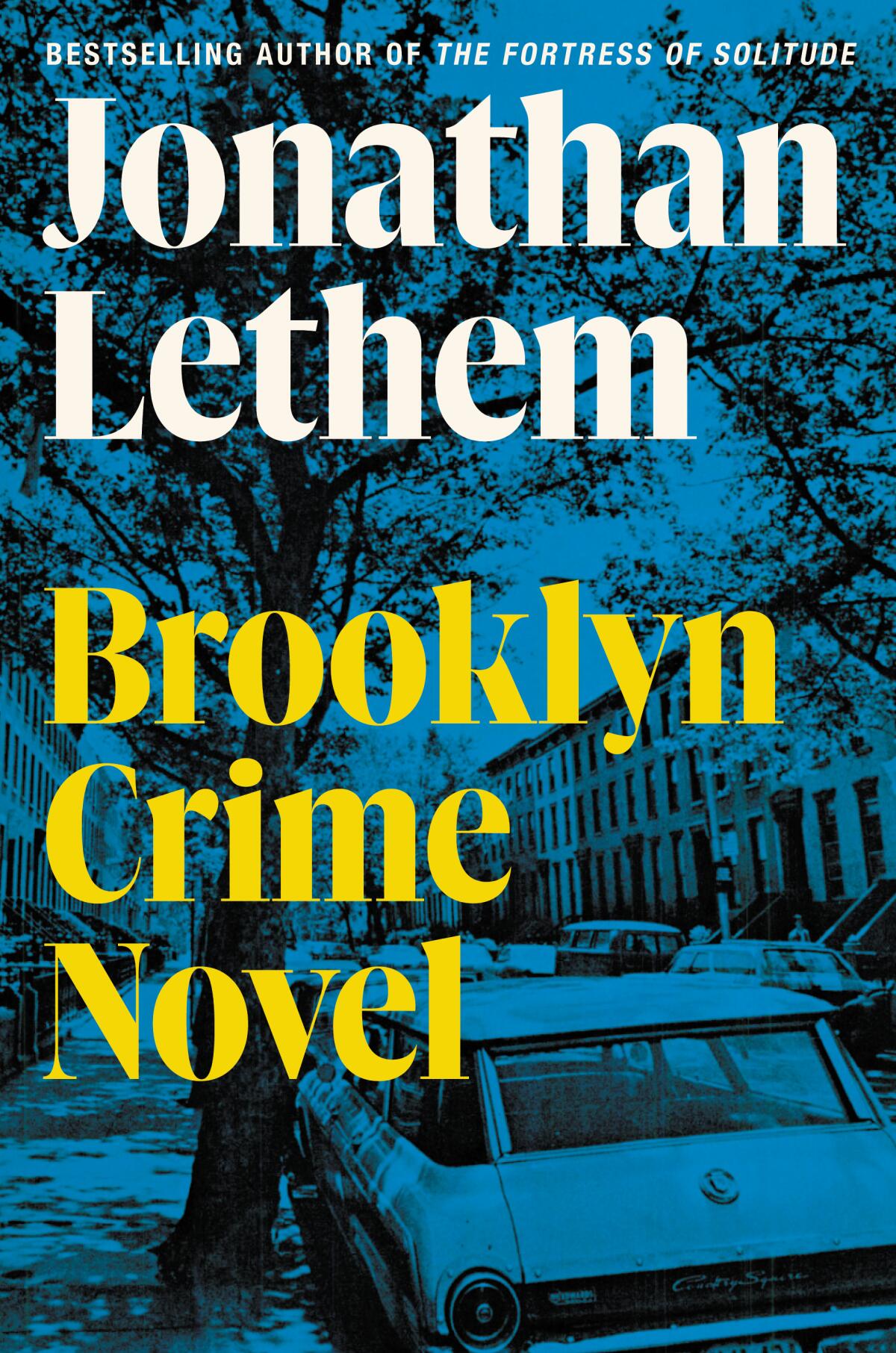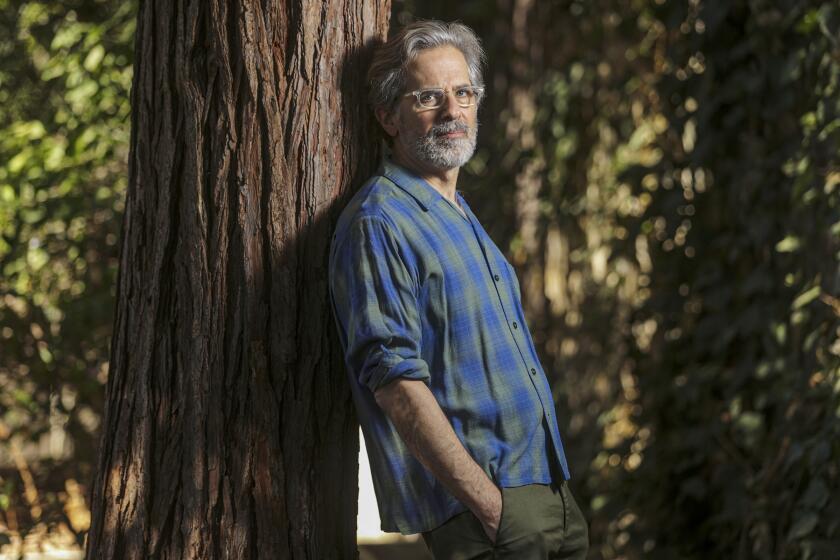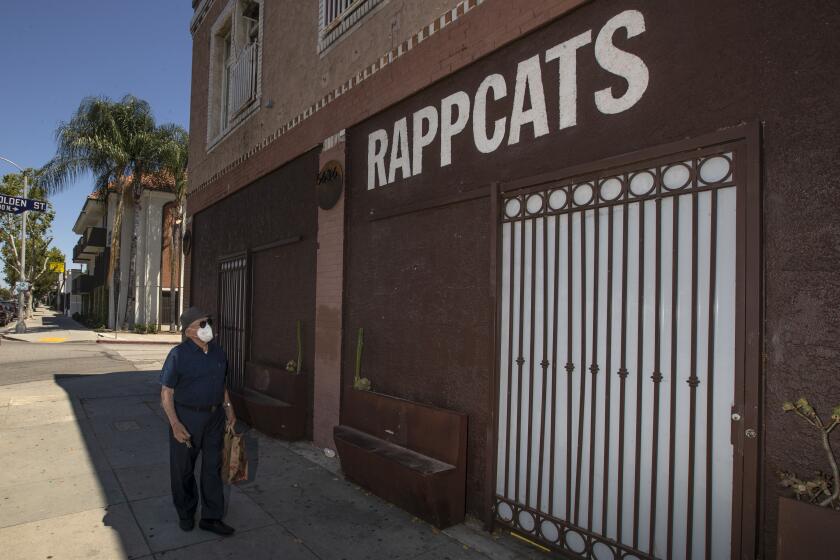Jonathan Lethem revises the Brooklyn of his youth â and his novels

Review
Brooklyn Crime Novel
By Jonathan Lethem
Ecco: 384 pages, $30
If you buy books linked on our site, The Times may earn a commission from Bookshop.org, whose fees support independent bookstores.
Though the novelist and Pomona College professor Jonathan Lethem has lived in Southern California for more than a dozen years, the Brooklyn neighborhood of Boerum Hill still looms large. Itâs been exactly 20 years since Lethem published âThe Fortress of Solitude,â a tribute to the Brooklyn of his youth. The landscape has changed considerably: steely grit and urban decay have given way to skyscrapers and endless bistros.
But this transformation was already well underway in 2003, when Lethem published his story of a complicated interracial friendship between two boys who grew up in the pre-gentrified 1970s. What more can be said about it now? According to the author of âMotherless Brooklynâ: a lot.
Lethemâs latest book, âBrooklyn Crime Novel,â explores familiar territory from a new point of view in a style new to him. It unfolds through passages ranging in length from less than a page to a dozen, each labeled and dated. And it leaps between decades and then into liminal spaces that exist across time to cast a light on forgotten exchanges and actions. This kaleidoscopic, fragmentary quality is no lark; it is essential to Lethemâs project.
The novelist perhaps most associated with Brooklyn lives in Claremont and has a delightful new dystopian novel out, âThe Arrestâ
Abandoning a central hero allows the streets to speak for themselves, with the powerful voice of an omniscient boy of Dean Street serving as interlocutor and guide. This is not to say âBrooklyn Crime Novelâ is devoid of characters. Lethem rounds out the book with figures such as C., a young Black boy (circa 1970s) who navigates smoothly among the various kids of the neighborhood regardless of race or background; and the Brazen Head Wheeze, a grizzled barfly and neighborhood institution who takes pleasure in heckling the yuppie-arrivistes 40 years later.

Overwhelmingly, though, Lethem sees the history of the area â the culmination of neglect followed by unchecked gentrification â not through the words of its native children but through their bodies. âThey came into consciousness in a distinct time and place,â he writes. âLater theyâd find evidence, deep inside their bodies, of how theyâd been formed by certain arguments that time and place was having about itself.â These are bodies inscribed by crimes. Lethem seeks to âuse what we know to know more than we know.â
At first glance, the bookâs stark title â coupled with Lethemâs frequent play with mystery tropes â signals that this is a genre novel. It is definitely not, but the question of crime remains. Dispensing with plot and narrative conventions, Lethem establishes a concrete language to catalog the sweeping range of crimes (or âthe danceâ as he sometimes refers to them): offenses ranging from muggings, kidnapping and assault to the displacement of working-class residents that accumulate to create a history of Boerum Hill.
This accumulation reaches a climax when the Wheeze confronts a Novelist (who we assume is Lethem) with the retort: âYou gentrified gentrification.â No criticism could be more personal or cutting.
As personal a story as âFortressâ was, it was also a fabrication. All these years later, Lethem wants to measure the cost and burden of microaggressions and capital offenses. Realizing one novel could never embody the beauty and tragedy of his home, Lethem uses this one to uncover the slipperiness of the task.
Highland Park has long been the heart of L.A.âs musical bohemia, home to Chicano punk and Billie Eilish. Now, COVID-19 threatens the sceneâs very existence.
âSome things, like a gentrification, or a trauma, canât be so simply placed in time,â he writes. âThey exasperate before and after. They dwell instead in a null space, a long between. Distrust anyone who tries to pin them to the pages of a book.â Look, instead, for âwhat a small number of people remember, even if they avert their eyes when passing on the sidewalk.â The work of uncovering the full truth becomes a life sentence.
Itâs a brutal question to ask yourself: Was writing a book about your childhood friends and home turf an act of betrayal? Maybe it was if not everyone managed to survive to tell their stories. Complicating Lethemâs task is that Boerum Hill was contrived in the first place â invented in the 1960s to distinguish its fading brownstones from the surrounding housing projects. Peppering the book with critical observations, the narrator notes, âGeneralizations, then, may betray the spirit of our inquiry here. Letâs lay off the romantic flourishes, the rhetoric of memory.â This is no sugar-coated stroll down memory lane.
So yes, he has internalized the hardest knock on âThe Fortress of Solitudeâ: That for all its sharpness and grit, it is ultimately sentimental and thus incomplete. Here, Lethem lets the ragged edges remain visible. The storyâs texture and pacing echoes his message. âBrooklyn Crime Novelâ is also a product of the 20 years that have passed since âFortressâ â not only in the borough but also in fiction. In the aftermath of autofiction, readers are more comfortable with experimental form and granular, knotted truths.
When âFortressâ came out, Lethem was 39, not yet a decade into his career as a novelist. At 59, he is a MacArthur-anointed âgeniusâ and Pomonaâs Roy Edward Disney Professor of Creative Writing. What he has chosen to do now isnât to capture the moment or stand out in a crowded market, but to write the book that has nagged at him. Heâs walking these familiar streets to see beyond the gauze of memory in order to reconcile feelings with facts.
Lili Anolikâs âOnce Upon a Time ... at Bennington College,â on the school days of Bret Easton Ellis, Donna Tartt and Jonathan Lethem, concludes this week.
In a recent essay in the New Yorker, Lethem writes about another writerâs attempt to analyze the phenomenon of Boerum Hill, back in 1977: âJervis Andersonâs gift was to portray the brownstoners as I recall them: people trying, and largely failing, to grasp their place in history in real time. You and I may be doing the same now.â
While âFortressâ is imbued with longing, âBrooklyn Crime Novelâ surveys the deep fissures that surface when the pull of home is stronger than nostalgia. He sees himself as an âunwillingâ detective, a designated ârememberer.â Ultimately, his is a pursuit with no definite answers, in which the good guys and bad guys sometimes switch roles due to forces beyond their control.
What more is there to say about Brooklyn? Lethemâs revisionist project ultimately unsays as much as it says. â[C]ertain matters fall into wells of silence without necessarily being lies...,â he writes. âThe street may seem to swallow knowledge about itself, to render certain things unsayable.â But the novel is also an endless declaration of love. Every neighborhood deserves such a discursive portrait, such ruthless devotion and such an audacious book.
LeBlanc is writer and a board member of the National Book Critics Circle. Her Substack is laurenleblanc.substack.com.
More to Read
Sign up for our Book Club newsletter
Get the latest news, events and more from the Los Angeles Times Book Club, and help us get L.A. reading and talking.
You may occasionally receive promotional content from the Los Angeles Times.











